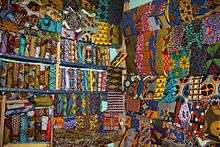African waxprints




Dutch Wax Prints also known as African wax prints are omnipresent and common materials for clothing in Africa, especially West Africa. They are industrially produced, colorful cotton cloths with batik printing.[1] One feature of these materials is the lack of difference in the color intensity of front and back side. The wax fabric can be sorted into categories of quality due to the processes of manufacturing.
Normally, the fabrics are sold in 12 yards as "full piece" or 6 yards as "half piece". The colors comply with the local preferences of the customers. Mainly clothing for celebrations is made out of these.
The wax prints are part of a nonverbal way of communication among African women, and hereby they carry their message out into the world. Some wax prints can be named after personalities, cities, building, sayings or occasions. The producer, name of the product and registration number of the design is printed on the selvage, protecting the design and allowing reading the quality of the fabric. The wax fabrics constitute capital goods for the African women. Therefore, they are collected depending on the financial possibilities.
The design of the wax print fabrics already has an influence on the international world of fashion and lifestyle. They are an inspirational source for designers and companies.
History
The process to make ankara is originally influenced by Batik, an Indonesian (Javanese) method of dyeing cloth by using wax-resist techniques. For Batik, wax is melted and then patterned across the blank cloth. From there, the cloth is soaked in dye, which is prevented from covering the entire cloth by the wax. If additional colors are required, the wax-and-soak process is repeated with new patterns.
Ankara is different from Batik in that it is made through the dutch wax method. This method was created by the Dutch during their colonization of Indonesia in the 1800s, with the goal of flooding markets with cheap machine-made imitations of Batik. Unfortunately for the Dutch, these imitation wax-resist fabrics did not successfully penetrate the Batik market. They did, however, experience a strong reception in West Africa when Dutch trading vessels began introducing the fabrics in those ports.
The dutch wax prints quickly integrated themselves into african apparel. Women used the fabrics as a method of communication and expression, with certain patterns being used as a shared language, with widely understood meanings. Many patterns began receiving catchy names. Over time, the prints became more african-inspired, and african-owned by the mid-1900s. They also began to be used as formalwear by leaders, diplomats, and the wealthy population.
Batik
The Javanese word batik designates a technology of coloring with spares where the coloring happens with an ink repellent liquid or paste like wax, resin or starch. The spare material is applied, drawn or stamped on the fabric protecting these parts of the fabric (pattern) in the color bath and creating a light pattern after removal.
Fancy
The costly produced wax fabrics are increasingly imitated by alternative ways of manufacturing. The so-called "fancy fabrics" are produced in a printing procedure. Costly designs are printed digitally.
Fancy fabrics in general are cheap, industrially produced imitations of the wax prints and are based on industry print. Fancy fabrics are also called imiwax, Java print, roller print, le fancy or le légos. These fabrics are produced for mass consumption and stand for ephemerality and caducity. Fancy Fabrics are more intense and rich in colors than wax prints and are printed on only one side.
As for wax prints, producer, product name and registration number of the design are printed on the selvage. Even the fancy fabrics vary with a certain fashion. The fabrics are limited to amount and design and are sometimes exclusively sold in own shops.
See also
References
- ↑ Gabriele Gerlich: Waxprints im soziokulturellen Kontext Ghanas (PDF, 2,1 MB). Online Institut für Ethnologie und Afrikastudien, page 1.
Literature
- Gerlich, G.: „Waxprints im soziokulturellen Kontext Ghanas“. Arbeitspapier Nr. 54. Institut für Ethnologie und Afrikastudien. Johannes Gutenberg Universität Mainz, 2004
- Gillow, J.: African textiles. Colour and creativity across a continent. London: Thames & Hudson Ltd, 2003
- Joseph, M. L.: Introductory Textile Science. 2. Aufl. New York: Holt, Rinehart and Winston, 1972
- Luttmann, I. : „Die Produktion von Mode: Stile und Bedeutungen.“ In: Ilsemargret Luttmann (Hrsg.): Mode in Afrika. Mode als Mittel der Selbstinszenierung und Ausdruck der Moderne. Museum für Völkerkunde Hamburg, 2005, pages 33–42.
- Picton, J.: “Technology, tradition and lurex: The art of textiles in Africa.” In: John Picton (Hrsg.): The art of African textiles. Technology, tradition and lurex. London: Lund Humphries Publishers, 1995, page 9-32; 132.
- Rabine, L. W.): The global circulation of African fashion. Oxford: Berg, 2002
- Schaedler, K. F.: Afrikanische Kunst. Von der Frühzeit bis heute. München: Wilhelm Heyne Verlag, 1997
- Sarlay A., Jurkowitsch, S.: „Entdecken der Vorarlberger Stickereien in Westafrika“, Wirtschaftskammer Vorarlberg, 2009
- Sarlay A., Jurkowitsch, S.: An analysis of the current denotation and role of Wax & Fancy fabrics in the world of African textiles, International Journal of Management Cases 01/2010; 22:28-48.
- Storey, J.: Manual of Textile Printing. New York: Van Nostrand Reinhold Company, 1974
- Koné, F. B.: „Das Färben von Stoffen in Bamako.“ In: Bernhard Gardi (Hrsg.): Boubou c´est chic. Gewänder aus Mali und anderen Ländern Westafrikas. Museum der Kulturen Basel. Basel: Christoph Merian Verlag, 2000, pages 164-171.
External links
| Wikimedia Commons has media related to African waxprints. |